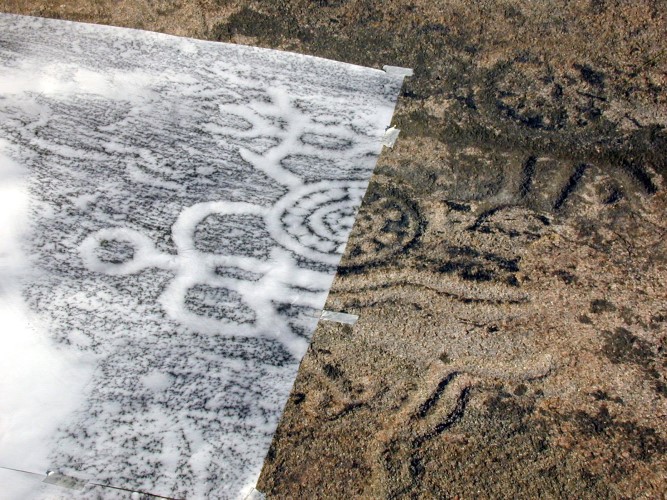 Photo 1
Photo 1
Archaeological petroglyph, Sweden. The paper is lightly taped and colored for the background debossing to become visible. This is negative imprinting since the background is replicated.
Stone Rubbing
Rubbing is one of the oldest techniques used in printmaking, created by carefully pressing paper onto a carved or incised surface so that the paper conforms to replicate the features on the original. The paper is then inked as the raised surface areas become colored, while indented areas remain white. Rubbings of graphite, charcoal, chalk, wax, and ink have been pulled from brass plates, stone carvings, monuments, and fish for centuries. Japanese fishermen used rubbings to record the size of the various fish they caught while Buddhist texts were rubbed from wooden blocks in Japan as early as 8th century AD. The archaeological petroglyph in photo 1, from Sweden illustrates the rubbing of the raised background to show early recessed carvings.
 Photo 1
Photo 1
Archaeological petroglyph, Sweden. The paper is lightly taped and colored for the background debossing to become visible. This is negative imprinting since the background is replicated.
Stone Rubbing
Brasses
Brass monuments were introduced in the thirteenth century throughout northern Europe as a memorial to the dead. Brass was flat, durable yet soft enough for engraving, and could be placed on the floor, wall, or top of a tomb. (photo 2) These engravings could be as simple as a marker with name, birth and death or as an elaborate carving with figures, canopy, heraldic shields, religious emblems, and inscription. A large monumental brass was composed of one or more pieces of brass plate set into the surface of a stone slab which was laid in a church either as a grave cover or as a memorial without burial.
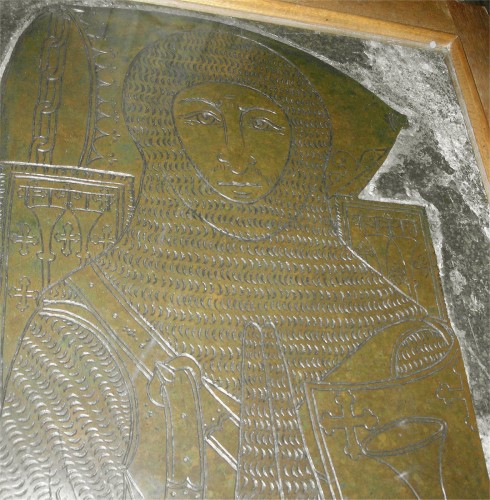 Photo 2
Photo 2
Portion of Sir Roger de Trumpington brass monument embedded in stone at parish church of Trumpington, Cambridge, England. The brass is protected by a clear sheet.
Stone Rubbing
These resulting monuments have served in various ways as historical documents, allowing a pictorial history of armor from the early fourteenth to seventeenth century; vestments of clergy from priest to archbishop; and fashion in men's dress from tunic to knee-breeches and women's attire for over a five hundred year period. The Victorians developed the art of brass rubbing, while clergymen found it a way of preserving a record of their church. Since World War II Americans have delighted in discovering brass rubbing and spent hours searching out the perfect brass to duplicate throughout Europe.
Rubbing Materials
Common rendering materials include charcoal/graphite, inksticks, or wax sticks—not crayons. In Asia ground stick ink is used, and in the West, a mixture of wax and carbon black, called heelball, is popular for gravestone rubbings. A carefully made rubbing provides an accurate, full-scale facsimile of the surface reproduced. A brass rubbing is a particular form of relief printing—unlike a traditional block print—in which the top of the paper is rubbed with a wax stick to pick up the raised texture beneath. Brass rubbings are generally created as black on white paper, or metallic gold or silver on black paper. (photo 3A and 3B) Thus a creation of an image from stone or brass to paper is much like a tracing.
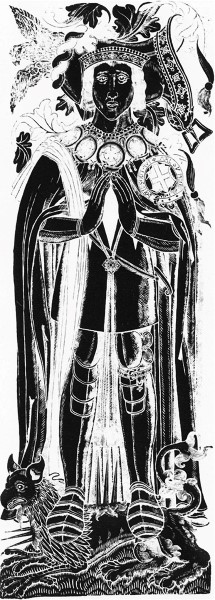
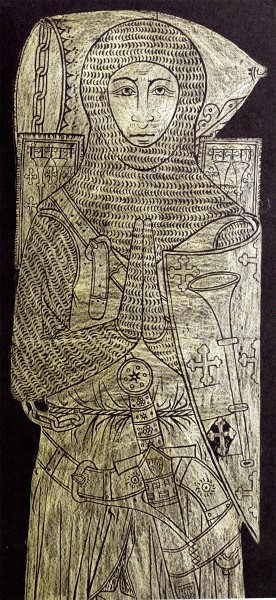 Photo 3
Photo 3
Black on white (L) Thomas Boleyn, Kent UK, or metallic on black (R) Sir Roger de Trumpington, UK, c. 1289, are most common rubbings. Both are samples of positive imprinting since the actual image is replicated.
The engraved design on the brass is transferred to paper by rubbing it with a special hard wax called a heel ball—a mixture of beeswax, tallow and lamp black developed in the 1830’s. Originally called cobbler’s wax it was used by shoemakers who held a ball of it in the heel of their hands to wax the thread as they worked, hence the name heelball. It is currently available in natural colors of black gold, silver, bronze, and copper.
Inksticks and ink cakes are a solid block ink used traditionally in several East Asian cultures for calligraphy and brush painting. Inksticks are made mainly of soot and animal glue. The inkstick is ground against an ink stone with a small quantity of water to produce a dark liquid which is then applied with a brush. Artists and calligraphers vary the concentration of the ground ink to their preference by reducing or increasing the intensity and duration of ink grinding. The ink required for pouncing needs to be thicker than used for calligraphy or art.
Chinese Inscriptions
The Chinese scholars carved inscriptions into stone as a way of preserving its history and culture. Records of important events were inscribed on bone and bronze as early as the second millennium B.C., but the medium most used for long inscriptions was stone. By the beginning of the seventh century the Chinese were inscribing old records into stone that could be used as a master to recreate multiple inscriptions on paper with ink as prints. These copies could then be easily transported and distributed in volume.
 Photo 4
Photo 4
Mulberry paper is aligned onto the stone tablet and debossed into the characters using a wooden mallet and felt pad to prepare for inking.
Joseph Scheer Blog, "Ink rubbings, Forest of Stone Tablets-Xi'an China-Preparing the Paper".
To begin the transfer process, lightly moistened xuanzhi—Shuen paper, rice paper—is aligned over the stone tablet which is then tapped with a moistened felt pad and mallet, or brush, to work the paper into recessed areas as it softens, in preparation for inking. (photo 4) Stick ink is ground in an inkstone as water is added one drop at a time for desired consistency and filled into a cloth. The ink is then stippled—pounced, tapped—onto the paper without bleeding into the engravings using the cloth to apply ink to the background negative spaces. When the soft ink filled pad touches the hard stone under the paper, it gives out some ink that is quickly absorbed by the paper. This is repeated until desired blackness is achieved. When done the paper is allowed to dry and peeled off. (photo 5)
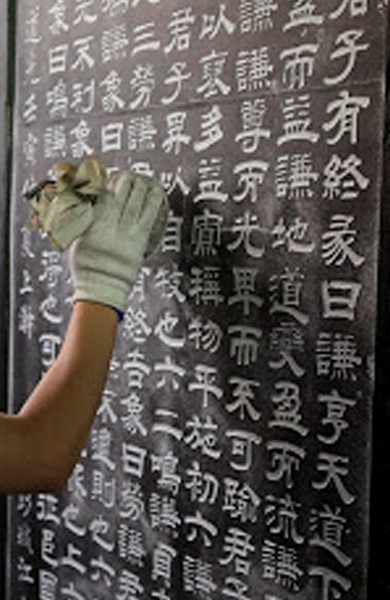 Photo 5
Photo 5
Ink is pounced onto the prepared paper filling the negative spaces to reveal uninked areas as white characters on a black background.
Joseph Scheer Blog, "Ink rubbings, Forest of Stone Tablets-Xi'an China-Preparing the Paper".
Damage and Erosion
Rubbings made a century ago preserve a far better record of the inscription than the stone itself, which may have suffered from natural erosion, or damage caused by having been tamped in the process of taking thousands of rubbings. Thai, Siamese, Cambodian, and Mayan carvings are created from stone or clay and the process of creating rubbings has degraded them. These rubbings are most often done with softer less aggressive materials like chalk or ink on various natural papers, the best having been done by monks. Typically they are made from black charcoal chalk on a white background, but are also found brown or blue. In 1995 the Thai government banned the process of Temple Rubbings and the exportation of any rubbings for the protection of their historical temple carvings.
The brass plaques in UK found are found in churches having been popular between the thirteenth and sixteenth centuries. Brass rubbings are created by laying a sheet of paper on top of a brass then burnishing the paper with hard, colored wax. Brass plaques are also being abraded by the process and in many cases rubbing has been banned from touching. Fortunately brass rubbing centers have opened with smaller replicas of the beautiful original brass plaques as a destination in the UK for tourist and visitor rubbings.
Mounting and Framing
Since rubbings are generally used to reproduce surfaces carved or incised by someone other than the person who makes the rubbing, the end product is not considered an original print but rather an accurate record of the work of others. This is why dry mounting and pressure-sensitive adhesives are accepted methods for mounting of them.
Purchased Chinese rubbings are often folded into small 5x7" pieces for ease of transport, which is often a problem for Western framers. Creases matter not when Asian wet mounting methods are implemented for mounting. Heavily creased or wrinkled rubbings will require starch mounting to kozo backing to remove and flatten the creases. This is not a recommended practice for framers without training, and is only suggested for inked stone rubbings not wax over brass rubbings. (photo 6)
 Photo 6
Photo 6
Heavily creased or folded rubbings will require starch mounting to kozo paper as a reinforcement backing for strength and stability. All folds will disappear.
Wax rubbings use hard wax sticks which begin to soften at 170°F, so dry mounting with any HA board or tissue above 150°F is ill-advised. Selecting low temperature 130°F HA board in a well calibrated machine would be best. (photo 7)
 Photo 7
Photo 7
Since hard wax melts at 175°F then low temperature 130°F HA board mounts well as long as the rubbing is flat, and permanent bonding is appropriate. Samples here were created for heat tolerance testing.
Pressure-sensitive adhesives and boards are also an option for mounting, but the rubbing itself would determine if this was a viable option as it would require a flat, non-cockled rubbing. The preservation mounting alternative should also be considered which would allow a lightly cockled rubbing to simply do its own thing by being preservationally hinged, edge-stripped or sink mounted depending on the flatness of the paper. That would preserve the memory for generations allowing the paper to fade in its own time and to expand and contract at will.
Final Rub
Memorabilia of rubbings have been framed for decades, and since some have been created with light fugitive, acidic materials the mounting and handling of them may not be a high preservation issue. But the thing to consider is since the original stones and brasses have become protected, original artifact rubbings are becoming rare and irreplaceable. So even if the rubbing you have to frame has little monetary value, was not taken from an original artifact but a smaller replica, or is only available as a high priced antiquity...it may be a memory from an irreplaceable trip. Threat it with care.
END
Copyright © 2019 Chris A Paschke
Resources—Items
https://www.hamline.edu/offices/archives/brass-rubbings/introduction.html—(History, English Brass)
http://www.lib.berkeley.edu/EAL/stone/rubbings.html—(background)
https://en.wikipedia.org/wiki/Stone_rubbing
For more articles on mounting basics look under the mounting section in Articles by Subject.
Additional information on all types of mounting is found in:
The Mounting and Laminating Handbook, Second Edition, 2002,
The Mounting And Laminating Handbook, Third Edition, 2008 and
Creative Mounting, Wrapping, And Laminating, 2000 will teach you everything you need to know about getting the most from your dry mount equipment and materials as an innovative frame designer.
All books are available from Designs Ink Publishing through this website.
Chris A Paschke, CPF GCF
Designs Ink
Designs Ink Publishing
785 Tucker Road, Suite G-183
Tehachapi, CA 93561
P 661-821-2188
chris@designsinkart.com